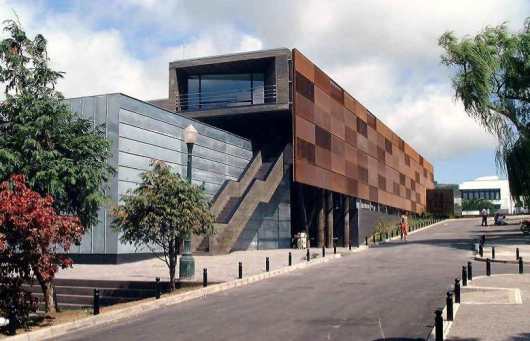Venue
The venue is in the University of Azores, campus of Ponta Delgada, São Miguel Island.

Address:
Universidade dos Açores
Campus de Ponta Delgada
Apartado 1422
PT - 9501-801 Ponta Delgada
Açores, Portugal
For more information: http://www.uac.pt/localizacao
The conference Hotel is Hotel Açores Atlântico (http://www.bensaude.pt/en/hotels-azores/ponta-delgada/hotel-acores-atlantico/)
Address: Avenida Infante D. Henrique, 113
9500-150 Ponta Delgada
S. Miguel - Azores
Tel: +351 296 302 200
Getting to São Miguel
The best way to get to Săo Miguel is by plane. There are daily flights to Lisbon, a two-hour trip, and links to Boston (USA) and Toronto (Canada). Sata Air Açores flies daily to the other islands of the archipelago.
From May to October, one can get to the other islands by ferry boat.
Direct Flights from Lisbon to Ponta Delgada are:
http://www.sata.pt/en/content/home-page
http://www.flytap.com/Portugal/en/Homepage
Localisation
Săo Miguel is called the Green Island. Located 25ş 30’W and 37ş 50’N, it is the biggest island of the archipelago, 759, 41 sq km, 65 km length and 14 km width. Săo Miguel and Santa Maria form the Eastern Group of the Azorean archipelago.
Discovery and settlement
In the middle of the XIV century, its existence was already registered in geographic maps. However, it is supposed that it was only discovered between the years of 1426 and 1439. The settlement began in 1439 with Portuguese coming from the provinces of Estremadura, Algarve, Alto Alentejo, and also some foreigners coming mainly from France.
Transports
The visitor can choose between rent a car, use a cab or the bus lines that cover the island.
Places to visit
-
Sete Cidades has two lagoons (a green and a blue one) in the interior of a crater with 12 km of perimeter.
-
Pico do Carvăo is a viewpoint overlooking the island’s centre and the sea; it is surrounded by several lagoons, outstanding the lagoons of Canário, Rasa and Carvăo due to their dimensions.
-
Miradouro do Escalvado is located in Ponta do Escalvado and it is a belvedere of Mosteiros parish and a viewpoint of a magnificent sunset.
-
Caldeiras da Ribeira Grande is a small group of fumaroles nearby the access to Vale das Lombadas, where is located a spring with the same name.
-
Praia dos Moinhos is a beach of a large strand of sand, located in the parish of Porto Formoso.
-
Praia Areal de Santa Bárbara, probably the largest sandy area, is much appreciated by surfers.
-
Gorreana and Porto Formoso are tea grounds where tea factories can be visited.
-
Lagoa do Fogo is a lagoon in the interior a crater of an extinct volcano, and it is part of a natural reserve.
-
Caldeira Velha is located in the hillside of Lagoa do Fogo, and is a small lake of warm water where you can take a pleasant bath.
-
Ilhéu da Vila Franca is a natural reserve, an islet that keeps inside a natural swimming pool. It can be visited from June to September taking the boat in the Tagarete quay in Vila Franca do Campo.
-
Lagoa do Congro is nearby Vila Franca do Campo and worthy of a visit.
-
Pinhal da Paz, another reserve, offers a splendorous sight of azaleas flourishing.
-
Vale das Furnas is a valley that has fumaroles, hot water, and medicinal mud and water. It is crossed by two streams, being one of them of hot water. More than twenty thermal springs run through the village-places, being so considered one of the biggest hydro polis of the world. Nearby the Furnas lagoon, pay a visit to Nossa Senhora das Vitórias Chapel and the place where the famous hollows meat course is boiled under the ground. Between noon and 15h, you can observe the meat course being taken from the hollow on earth.
-
Parque Terra Nostra, a park located in the centre of the parish, keeps a great variety of tree and exotic plants, as well as a heated swimming pool.
-
Pico do Ferro and Salto do Cavalo are belvederes overlooking the Furnas valley and Povoaçăo Village.
-
Ribeira Quente, a fishing village-place, has an excellent beach (Praia do Fogo) and the road that access to the parish has magnificent waterfall.
-
Nordeste is a part of the island full of mountains, narrow passes, springs and belvederes. Pico da Vara, the highest point of the island with 1105 m, the belvederes of Pico Bartolomeu, Ponta do Arnel and Ponta da Madrugada, where a beautiful sun rise can be watches expect your visit. There are also several forest parks, a camping park in Ribeira do Guilherme, a fishing port and Lombo Gordo beach.
-
The pineapple greenhouses in Fajă de Baixo, Lagoa and Vila Franca do Campo are the places where the famous Azorean pineapple is grown. Jardim António Borges and Jardim José do Canto are gardens where one can find rare vegetal species.
-
Museu Carlos Machado is a museum that keeps collections of paintings, glazed tiles, porcelains and pieces of national history.
-
Convento da Esperança is the convent where one can admire the famous image of Senhor Santo Cristo dos Milagres.
More information about São Miguel Island can be found at http://www.azorestourism.com/english/guia/smiguel.php










.jpg)